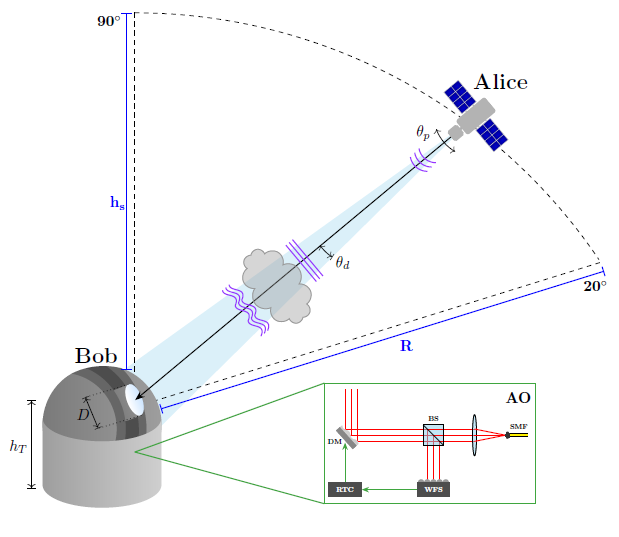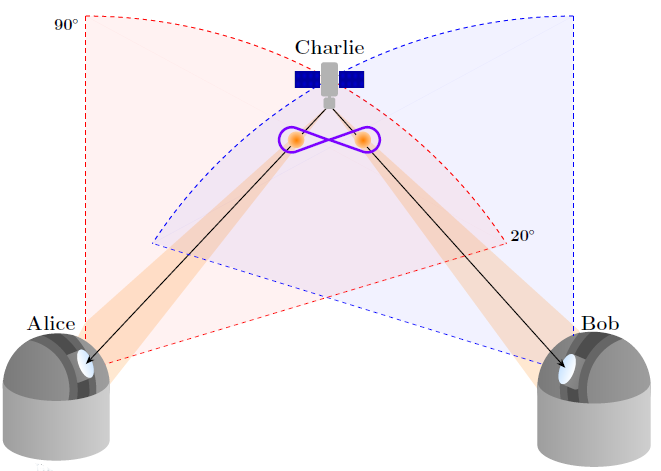Contacts : Jean-Marc Conan (jean-marc.conan @ onera.fr)
ONERA has been conducting research for over 40 years into the propagation of optical waves through atmospheric turbulence, and the real-time correction of disturbances using adaptive optics. This work serves and feeds a wide range of applications: defense, ground-based astronomy, optical links for high-stability frequency transfer, ultra-high-speed telecoms and quantum communications.
Quantum communications" is Axis 1 of Labo QTech's activities. This work is currently focused on quantum cryptography concepts, in particular Quantum Key Distribution (QKD), based on optical ground-satellite links. QKD exploits the quantum properties of light to enable two parties (often named Alice and Bob) to share a secret key with unconditional security.

Quantum key distribution « Prepare & Measure »
where the key is shared between the satellite and a ground station
(the ground station's adaptive optics is shown schematically
[Credit Valentina Marulanda Acosta (2023)]
Indeed, a major challenge for large-scale deployment of quantum communications is the ability to establish long-distance links. However, unlike the classical signal, the quantum signal cannot be amplified, so direct transmission of quantum information through optical fiber over arbitrarily long distances is not possible. Quantum repeater technology, requiring high-efficiency quantum memories, is currently under development. In parallel, quantum communication using satellite links is seen as a very promising solution for transcontinental communications.
This activity is carried out as part of a collaboration with Eleni Diamanti (LIP6) and Caroline Lim (LNE, SYRTE). The collaboration was initiated in 2019, and a co-supervised thesis (Valentina Marulanda Acosta) was defended in December 2023. This work is also being carried out in collaboration with Daniele Dequal (ESA).
The work carried out demonstrates, for LEO-ground QKD downlink systems, that adaptive optics brings a gain in key exchange rate of several orders of magnitude. The analysis is based on numerical simulations including fine modeling of the entire chain: the turbulent channel and the adaptive optics, as well as QKD performance evaluation for continuous variable (CV-QKD) and discrete variable (DV-QKD) protocols [MarulandaAcosta-2024].
This work will soon be extended to quantum communication networks with unreliable nodes. In this context, we use the satellite as a simple relay (named Charlie) between two ground stations, without imposing any reliability constraints on the space segment. Different strategies are envisaged: emission by the satellite of a pair of entangled photons to two ground stations; use of two ground-to-satellite uplinks where a Bell measurement is performed via a one- or two-photon interference process (Twin Field and Measurement Device Independent approaches respectively). Our recent developments on an innovative strategy to improve uplink correction [Lognoné-2023] should prove a decisive asset for the latter protocols. More generally, our research on the ground-space channel to improve its performance [Robles-2023a, Vène-2023] or predict its availability [Klotz-2023] is in strong synergy with our work in quantum communications.

Approach based on the satellite's emission of a pair of entangled photons
in the direction of two ground stations. [Credit Valentina Marulanda Acosta (2023)]
The outlook is for experimental validation in the laboratory around our PICOLO ground-space turbulent channel emulator [Robles-2023b], combined with adaptive optics, and eventually between a satellite and our FEELINGS and PROVIDENCE ground stations (see: https://www.onera.fr/fr/feelings https://www.onera.fr/en/providence).
This work is in line with the prospect of implementing quantum information networks on a global scale. Such networks pave the way for a wide range of applications, from quantum key distribution (QKD) and several other quantum cryptography primitives, to distributed computing and sensing by remotely interconnecting quantum processors and sensors, respectively. The overall vision is that as more and more advanced technologies become available, they should be integrated into these networks, enabling the realization of increasingly complex functionalities.
References
[MarulandaAcosta-2024] V. Marulanda Acosta et al. “Analysis of satellite-to-ground quantum key distribution with adaptive optics,” New J. Phys. (2024). https://doi.org/10.1088/1367-2630/ad231c
[Klotz-2024] E. Klotz et al., “Assessment of adaptive optics-corrected optical links statistics from integrated turbulence parameters through a Gaussian process metamodel,” International Journal of Satellite Communications and Networking (2024). https://dx.doi.org/10.1002/sat.1497
[Lognoné-2023] P. Lognoné et al., “Phase estimation at the point-ahead angle for AO pre-compensated ground to GEO satellite telecoms”, Optics Express (2023). https://doi.org/10.1364/OE.476328
[Robles-2023a] P. Robles et al., “Predictive adaptive optics for satellite tracking applications: optical communications and satellite observation”, SPIE Astronomical Telescopes + Instrumentation, (2022). https://doi.org/10.1117/12.2630217
[Robles-2023b] Pablo Robles et al. "Emulating and characterizing strong turbulence conditions for space-to-ground optical links: the PICOLO bench," JATIS (2023). https://doi.org/10.1117/1.JATIS.9.4.049002
[Vène-2023] T. Vène et al., “Revisiting Shack-Hartmann wavefront sensor design for space-ground communications in strong scintillation conditions”, In AO4ELT 7th Edition (2023). https://doi.org/10.13009/AO4ELT7-2023-107
